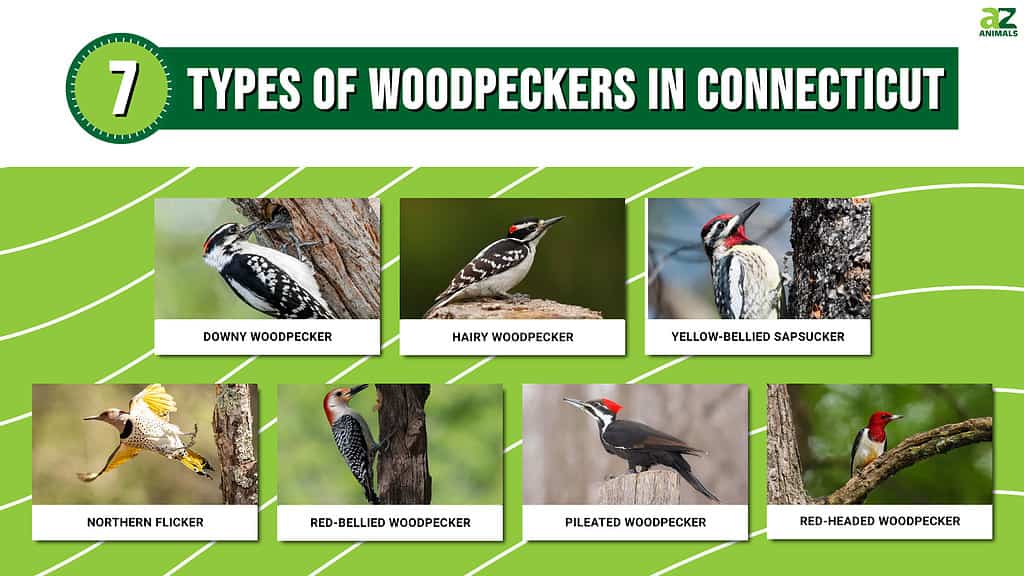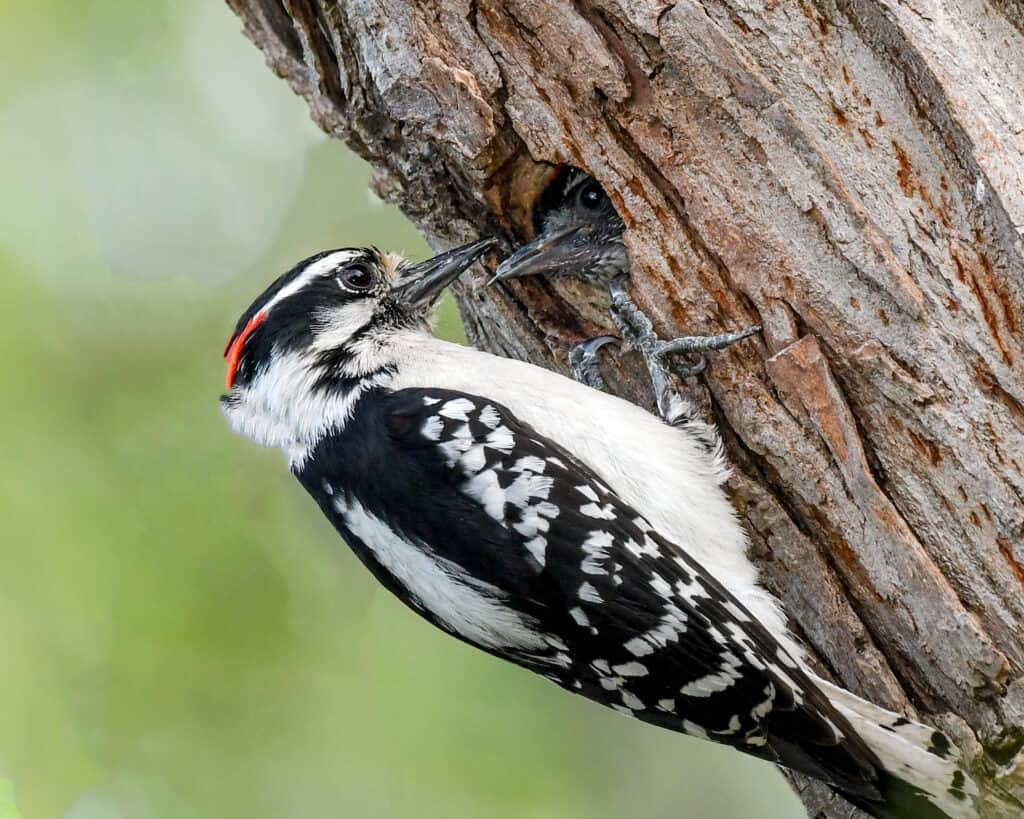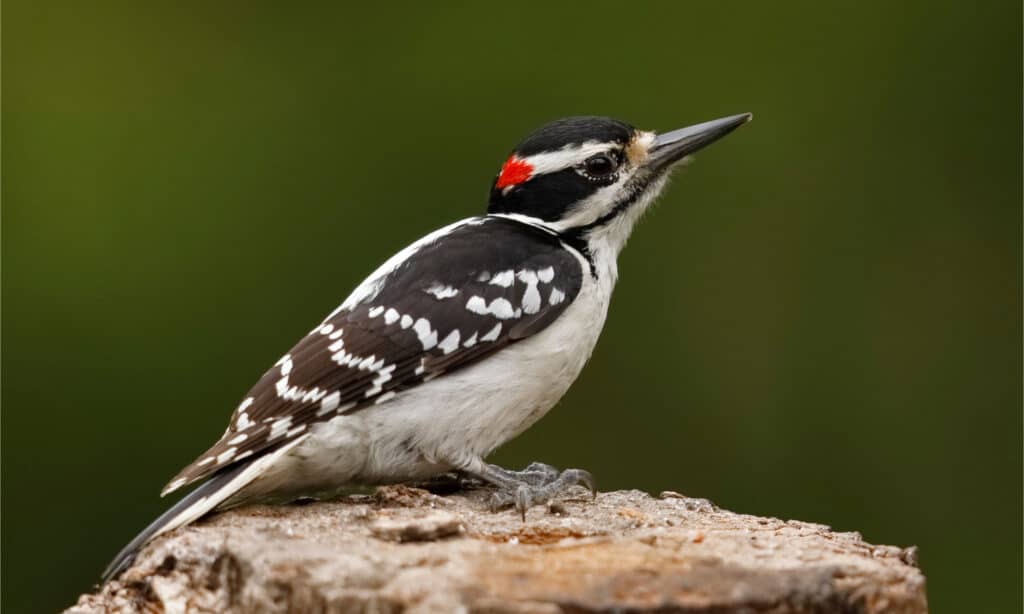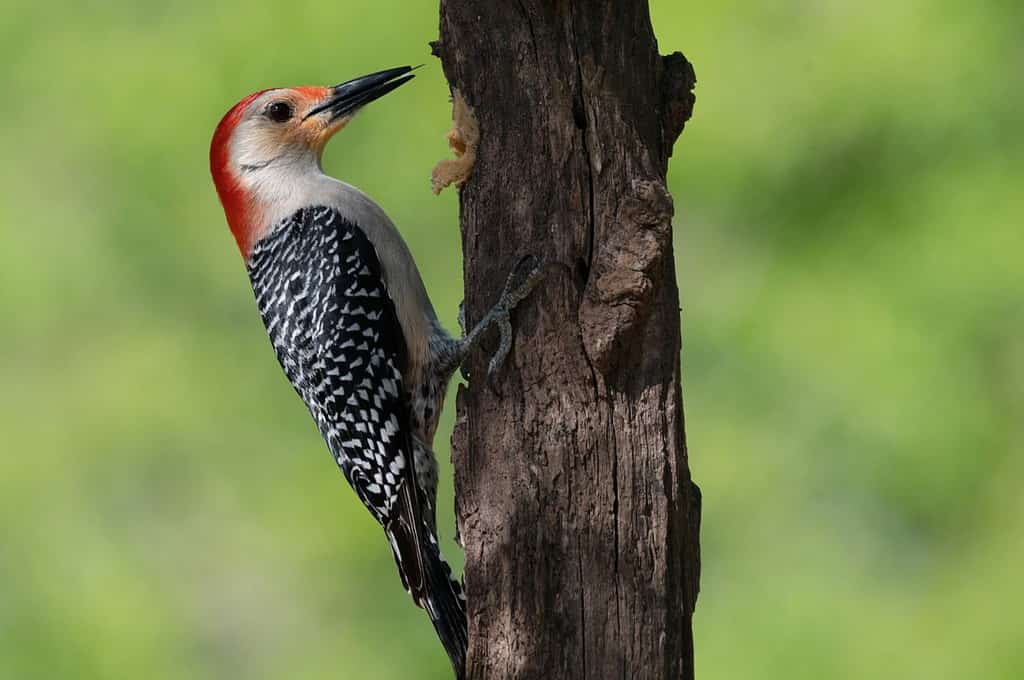In the lush woodlands of Connecticut, a diverse array of woodpeckers takes flight. From the vibrant red-headed flicker to the elusive pileated woodpecker, this guide unveils seven captivating species that grace our state’s trees. Discover their unique features and where to spot woodpeckers in Connecticut.

7 Types of Woodpeckers in Connecticut
Woodpeckers are highly beneficial to the Connecticut ecosystem and to other animals. They help to keep insect populations in check, as they eat both adult insects and larvae. They also help disperse the seeds of trees and other plants, aiding in the growth of new vegetation. Woodpeckers also create nesting cavities in trees, which provide homes to other wildlife, such as chickadees and owls. Finally, woodpeckers are important indicators of forest health. Here are the 7 beautiful woodpeckers in Connecticut.
1. Downy Woodpecker

Downy woodpeckers have black wings with lovely white spots.
©Brent Barnes/Shutterstock.com
The downy woodpecker has black wings with white spots and a white stripe on its back, with a white underbelly. Males are bigger than females and have a red patch on the back of their neck, which is absent in females. Both sexes have a noticeable puff of feathers above their beak. They are smaller than the hairy woodpecker (around 6 to 7 inches) and have a shorter bill. The yellow-bellied sapsucker looks similar but has white stripes on its wings instead of its back.
Downy woodpeckers live in woodlands, orchards, and even some residential areas. They feed on insects, larvae, and eggs found in bark crevices, as well as berries, snails, seeds, and spiders. Nesting is usually at heights of 15 to 30 feet (up to 50 feet) off the ground. Incubation of the 4 to 5 white eggs takes around 12 days, and the young woodpeckers will leave the nest in approximately 24 days. In Connecticut, downy woodpeckers typically raise one brood per season.
2. Hairy Woodpecker

Hairy woodpeckers have square heads and long bills.
©Brian Lasenby/Shutterstock.com
You can recognize the hairy woodpecker by its black wings with white spots and a white stripe down its back, accompanied by a white underbelly. Male hairy woodpeckers are larger than females and have a red patch on the nape of their neck, which is absent in the female. These birds measure between 7-10 inches in size and have a longer bill than their downy woodpecker counterparts.
Hairy woodpeckers prefer to reside in mature, extensive mixed forests where they feed on insects, their larvae, spiders, ants, and grasshoppers. They also eat nuts, seeds, and sap from sapsucker wells. These woodpeckers build their nests in trees that are between 5 and 30 feet off the ground. They lay up to 6 white eggs, and the chicks take around 15 days to hatch. The babies leave the nest at 28 days. Hairy woodpeckers only lay eggs once per year.
3. Yellow-Bellied Sapsucker

These amazing birds use multiple calls to communicate with each other.
©iStock.com/impr2003
The yellow-bellied sapsucker is a medium-sized woodpecker, measuring up to 9 inches in length. Its wings have a black color with white striping on its back. There is a long wing strip running lengthwise down the wing. Its underside is a cream color with streaks. Male sapsuckers display a red forehead, crown feathers, and throat. The female birds have a white throat patch.
Yellow-bellied sapsuckers typically make their homes in forests and orchards. They primarily eat tree sap, which they get by drilling holes in trees. They also like to eat fruit, berries, insects, and the buds of trees. White birch is its favorite tree because of its high sap sugar content. They may even drink from hummingbird feeders. Additionally, some mammals like red squirrels and bats rely on the sapsucker’s sap wells for nourishment.
During the breeding season, they consume a higher amount of protein-rich insects. They usually build their nests in live trees, such as aspens, between 10 and 40 feet off the ground. An average clutch of eggs is 5 to 6, and the young leave the nest after 29 days. Both parents teach sap sucking to their offspring because it is a crucial life skill.
The yellow-bellied sapsucker is found in the Northeast and Midwestern U.S., as well as Canada. In winter, the sapsucker migrates south to places such as Texas, Panama, and the Bahamas.
4. Northern Flicker

The yellow-shafted northern flicker is one of the most beautiful woodpeckers in Connecticut.
©iStock.com/Irving A Gaffney
The Northern Flicker, a medium to large-sized woodpecker (around 12 inches), is divided into two types. There are red-shafted flickers and yellow-shafted flickers. They each have brown back and wings with black bars along the edges. They both have a tan face and a cream or grayish underside with dark black spots. The yellow-shafted flicker has yellow feathers under its wing and under its tail. It also has a red necklace, a gray hat, and a black mustache. The red-shafted flicker has red feathers under its wings and tail. It is wearing a black necklace, a tan hat, and a red mustache.
The northern flicker is most likely to be found in open areas with trees, such as parks and residential areas. Its main diet consists of insects, especially ants, as well as seeds and some fruits. Flickers nest in decaying trees or decomposing trunks, usually between 3-80 feet from the ground. They lay up to ten pure white eggs and incubate them for 12-14 days. The chicks leave the nest after 30 days. In Connecticut, the flicker is a migratory species that is often seen on the ground consuming large numbers of ants. One flicker can eat up to 3,000 ants per day!
5. Red-Bellied Woodpecker

If you are looking for woodpeckers in Connecticut, keep your eyes peeled for a red-bellied woodpecker.
©Connie Moore/Shutterstock.com
The red-bellied woodpecker is a large-sized bird measuring nine inches in length. They have distinctive black and white markings on the wings and a light tan or gray colored underside. Both male and female red-bellied woodpeckers have red coloring on their necks, while the male is also wearing a red hat.
Red-bellied woodpeckers can be found in open woodlands, orchards, and other areas with shade trees. They feed on fruit, insects, seeds, and vegetables. They also eat tree sap leftover from sapsucker wells. To prepare for winter, they cram insects and berries into tree bark to save it for later.
They typically nest between 5-65 feet above the ground in dead trees. They will also nest in live trees that have dead branches. The female lays 5 eggs, which she incubates for two weeks. The chicks leave the nest in 26 days. In Connecticut, they lay one brood per year.
6. Pileated Woodpecker

This is the largest species of woodpecker in Connecticut.
©Vlad G/Shutterstock.com
The pileated woodpecker is the biggest woodpecker in Connecticut. It is between 16-19 inches long. Males have red foreheads, red crest feathers, and red mustaches. Females have red crest feathers, black foreheads, and black mustaches. They both have black backs without stripes.
Pileated woodpeckers inhabit large areas of forests for nesting. Sometimes, you can even spot them nesting in parks that have many trees. They make oval-shaped holes for food and perfectly round holes for nests.
They nourish themselves with ants, acorns, beetles, nuts, and fruits. Egg-laying occurs in nests that are located 15-90 feet off the ground in live trees. On average, they lay 4-8 beautiful white eggs that hatch within 18 days. The young leave the nest after 28 days.
7. Red-Headed Woodpecker

The gorgeous red-headed woodpecker is a species of endangered woodpecker in Connecticut.
©vagabond54/Shutterstock.com
The red-headed woodpecker is a species native to Connecticut that is listed as state-endangered. It has a black back, white underside, and white inner wing patches that can be seen when it is in flight. The males have a red crown on their heads that extends over the neck, while the females only have red coloring on the neck.
Red-headed woodpeckers inhabit open forests full of deciduous trees. They also like to live in wood swamps and old fields. Their diet consists mainly of beetles, grasshoppers, wasps, and ants. They also love to eat centipedes and spiders. They are one of the few woodpeckers that are good at catching flying insects as well as drilling for them. When fruit is in season, they eat berries and small, ripe fruit. In the winter, they eat a lot of nuts and acorns. Before the winter season, you can see red-headed woodpeckers forcing insects and berries into the cracks in tree bark to save them for winter storage.
Red-headed woodpeckers create their nests in dead trees between 2-75 feet in the air. They will also borrow another animal’s nest for a season if it is convenient. These birds line their nests with wood chips for comfort. They lay between 5-8 eggs and keep them cozy and warm for 14 days. The chicks stay in the nest for 27-28 days.
The red-headed woodpecker is in danger in Connecticut and is one of the least common birds in the area. Farming has decreased, resulting in the loss of woodlots, which are essential for these woodpeckers. Moreover, starlings are competing with them for nesting spots, making their numbers even fewer.
Summary of 7 Woodpeckers in Connecticut
| Woodpecker | Scientific Name | |
|---|---|---|
| 1. | Downy Woodpecker | Picoides pubescens |
| 2. | Hairy Woodpecker | Leuconotopicus villosus |
| 3. | Yellow-Bellied Sapsucker | Sphyrapicus varius |
| 4. | Northern Flicker | Colaptes auratus |
| 5. | Red-Bellied Woodpecker | Melanerpes carolinus |
| 6. | Pileated Woodpecker | Dryocopus pileatus |
| 7. | Red-Headed Woodpecker | Melanerpes erythrocephalus |
The photo featured at the top of this post is © Birdiegal/Shutterstock.com
Thank you for reading! Have some feedback for us? Contact the AZ Animals editorial team.







